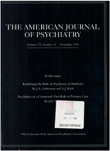Suicide in major depression
Abstract
OBJECTIVE: The purpose of this study was to examine a sample representing all suicide victims with current DSM-III-R major depression in Finland within 1 year in aspects relevant to suicide prevention, including comorbidity, clinical history, current treatment, suicide methods, and communication of suicide intent. METHOD: Using the psychological autopsy method, the authors examined all 71 suicide victims with current unipolar DSM-III-R major depression, taken from a random sample of 229 subjects representing 16.4% of all suicide victims in Finland in 1 year. RESULTS: The majority (85%) were complicated cases with comorbid diagnoses, and comorbidity varied according to the subjects' sex and age. Three-quarters had a history of psychiatric treatment, but only 45% were receiving psychiatric treatment at the time of death. Most suicide victims had received no treatment for depression. Only 3% had received antidepressants in adequate doses, 7% weekly psychotherapy, and 3% ECT. None of the 24 psychotic subjects had received adequate psychopharmacological treatment. Few (8%) had used an antidepressant overdose as a suicide method. Men had received less treatment for depression and had more commonly used violent suicide methods. CONCLUSIONS: Although about half of the suicide victims with major depression were receiving psychiatric care at the time of death, few were receiving adequate treatment for depression. There were significant sex differences in current and previous treatment and suicide methods. For suicide prevention in major depression, it would seem crucial to improve treatment and follow-up, for males with major depression, in particular.
Access content
To read the fulltext, please use one of the options below to sign in or purchase access.- Personal login
- Institutional Login
- Sign in via OpenAthens
- Register for access
-
Please login/register if you wish to pair your device and check access availability.
Not a subscriber?
PsychiatryOnline subscription options offer access to the DSM-5 library, books, journals, CME, and patient resources. This all-in-one virtual library provides psychiatrists and mental health professionals with key resources for diagnosis, treatment, research, and professional development.
Need more help? PsychiatryOnline Customer Service may be reached by emailing [email protected] or by calling 800-368-5777 (in the U.S.) or 703-907-7322 (outside the U.S.).



